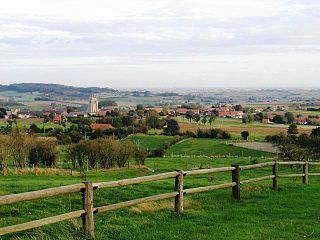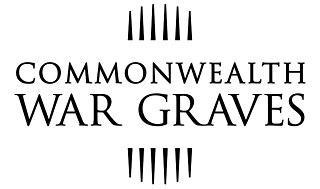
Heuvelland is a municipality located in the Belgian province of West Flanders. The municipality comprises the villages of Dranouter, Kemmel, De Klijte, Loker, Nieuwkerke, Westouter, Wijtschate and Wulvergem. Heuvelland is a thinly populated rural municipality, located between the small urban centres of Ypres and Poperinge and the metropolitan area of Kortrijk-Lille along the E17. On 1 January 2006 Heuvelland had a total population of 8,217. The total area is 94.24 km2 which gives a population density of 87 inhabitants per km2. The name heuvelland is Dutch meaning "hill country", as the municipality is characterized by the different hills on its territory.

The Commonwealth War Graves Commission (CWGC) is an intergovernmental organisation of six independent member states whose principal function is to mark, record and maintain the graves and places of commemoration of Commonwealth of Nations military service members who died in the two World Wars. The commission is also responsible for commemorating Commonwealth civilians who died as a result of enemy action during the Second World War. The commission was founded by Sir Fabian Ware and constituted through Royal Charter in 1917 as the Imperial War Graves Commission. The change to the present name took place in 1960.

A war grave is a burial place for members of the armed forces or civilians who died during military campaigns or operations.

Ploegsteert Wood was a sector of the Western Front in Flanders in World War I, part of the Ypres Salient. It is located around the Belgian village of Ploegsteert, Wallonia.

Brussels Cemetery is a cemetery situated in Evere, Brussels, Belgium. Located in the neighbouring municipality of Evere, rather than in the City of Brussels proper, it is adjacent to Schaerbeek Cemetery and Evere Cemetery, but should not be confused with either.

Tyne Cot Commonwealth War Graves Cemetery and Memorial to the Missing is a Commonwealth War Graves Commission (CWGC) burial ground for the dead of the First World War in the Ypres Salient on the Western Front. It is the largest cemetery for Commonwealth forces in the world, for any war. The cemetery and its surrounding memorial are located outside Passendale, near Zonnebeke in Belgium.

Zillebeke is a village in the Flemish province of West Flanders in Belgium. The former municipality is now part of Ypres.

Ramparts Cemetery is a Commonwealth War Graves Commission (CWGC) burial ground for the dead of the First World War located in the Ypres Salient on the Western Front.

The Ploegsteert Memorial to the Missing is a Commonwealth War Graves Commission (CWGC) memorial in Belgium for missing soldiers of World War I. It commemorates men from the Allied Powers who fought on the northern Western Front outside the Ypres Salient and whose graves are unknown. The memorial is located in the village of Ploegsteert and stands in the middle of Berks Cemetery Extension.

Ardennes American Cemetery and Memorial is a Second World War American military war grave cemetery, located in the village of Neuville-en-Condroz, near the southeast edge of Neupré, some 20 km (12 mi) south-west of Liège in Belgium. The cemetery, dedicated in 1960, contains 5,329 American war dead and covers 90.5 acres (36.6 ha). It is one of three American war cemeteries in Belgium, the other two being at Flanders Field and Henri-Chapelle and is administered by the American Battle Monuments Commission (ABMC).

William Hoey Kearney Redmond was an Irish nationalist politician, lawyer and soldier, who was killed in action in World War I.

Aldershot Military Cemetery is a burial ground for military personnel, or ex-military personnel and their families, located in Aldershot Military Town, Hampshire.

Railway Chateau Cemetery is a Commonwealth War Graves Commission (CWGC) burial ground for the dead of the First World War located in Belgium in the Ypres Salient on the Western Front.

Zillebeke Churchyard Commonwealth War Graves Commission Cemetery forms part of the village churchyard located around the Catholic parish church of Zillebeke in Belgium.

The St Symphorien Military Cemetery is a First World War Commonwealth War Graves Commission burial ground in Saint-Symphorien, Belgium. It contains the graves of 284 German and 229 Commonwealth soldiers, principally those killed during the Battle of Mons. The cemetery was established by the German Army on land donated by Jean Houzeau de Lehaie. It was initially designed as a woodland cemetery before being redesigned by William Harrison Cowlishaw after the Imperial War Graves Commission took over maintenance of the cemetery after the war.

The Hooglede German war cemetery is a military cemetery in the Belgian town of Hooglede, six kilometer northwest of Roeselare. It is located at the east side of Hooglede. It contains 8,241 buried German soldiers from World War I.

"The King's Pilgrimage" is a poem and book about the journey made by King George V in May 1922 to visit the World War I cemeteries and memorials being constructed at the time in France and Belgium by the Imperial War Graves Commission. This journey was part of the wider pilgrimage movement that saw tens of thousands of bereaved relatives from the United Kingdom and the Empire visit the battlefields of the Great War in the years that followed the Armistice. The poem was written by the British author and poet Rudyard Kipling, while the text in the book is attributed to the Australian journalist and author Frank Fox. Aspects of the pilgrimage were also described by Kipling within the short story "The Debt" (1930).

Hastings Cemetery is a cemetery in Hastings, East Sussex, England.

Lijssenthoek Military Cemetery is a Commonwealth War Graves Commission (CWGC) burial ground for the dead of the First World War in the Ypres Salient on the Western Front. After Tyne Cot, it is the second largest cemetery for Commonwealth forces in Belgium. Lijssenthoek Military Cemetery is located near Poperinge in the province of West Flanders. Most of those buried in the cemetery are war casualties who had been wounded near Ypres and later died in the four large Allied casualty clearing stations located in this area.

Bideford Higher Cemetery is the burial ground for Bideford in North Devon. Today it is managed by Torridge District Council.























